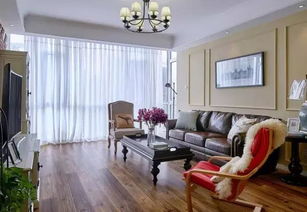Title: Exploring the Essence of American Minimalist Interior Design
In the realm of interior design, the American minimalist style stands out for its clean lines, functionality, and simplicity. Originating from the mid20th century, this design ethos has evolved into a timeless aesthetic that continues to captivate homeowners and designers alike. Let's delve into the key elements and principles that define the essence of American minimalist interior design.
Understanding the Basics
1. Clean Lines:
At the heart of American minimalist design is the emphasis on clean, straight lines. Furniture, architectural details, and decorative elements are characterized by their sleek and uncomplicated forms, devoid of ornate embellishments.
2. Functional Layout:
Functionality takes precedence in minimalist spaces. Rooms are carefully planned to optimize usability and flow, with furniture arranged to serve its purpose efficiently without cluttering the space.
3. Neutral Color Palette:
A muted color palette dominated by shades of white, beige, gray, and black sets the foundation for minimalist interiors. These neutral hues create a sense of serenity and space while allowing key design elements to stand out.
4. Abundant Natural Light:
Maximizing natural light is essential in minimalist design. Large windows, skylights, and strategically placed mirrors are used to amplify light levels, making the space feel bright, airy, and expansive.
Key Elements of American Minimalist Design

1. Functional Furniture:
Furniture pieces in minimalist interiors are selected for their functionality and simplicity. Streamlined sofas, sleek dining tables, and unadorned cabinets often feature prominently, with an emphasis on quality craftsmanship and materials.
2. Decluttered Spaces:
Clutter is the antithesis of minimalist design. Spaces are kept clutterfree through thoughtful storage solutions such as builtin cabinets, hidden storage compartments, and multifunctional furniture pieces that help maintain a sense of order and simplicity.
3. Textural Contrast:
While the color palette remains subdued, texture plays a vital role in adding visual interest to minimalist spaces. From smooth leather upholstery to natural wood grains and textured fabrics, incorporating a variety of tactile elements adds depth and warmth to the overall design.
4. Statement Artwork:
In minimalist interiors, artwork serves as focal points, adding personality and character to the space. Largescale paintings, sculptural installations, and carefully curated collections are showcased against clean, uncluttered walls, creating visual interest without overwhelming the senses.
Tips for Achieving the American Minimalist Look
1. Prioritize Quality Over Quantity:
Invest in wellcrafted, timeless pieces of furniture and decor that will withstand the test of time, rather than succumbing to fleeting trends.
2. Embrace Negative Space:
Allow for ample breathing room within your design scheme by incorporating plenty of negative space. This creates a sense of openness and tranquility, essential elements of minimalist design.
3. Edit and Simplify:
Regularly assess your space and edit out any unnecessary items or clutter that detract from the minimalist aesthetic. Strive for simplicity in both form and function.
4. Pay Attention to Detail:
Though minimalist design may appear simplistic, attention to detail is paramount. Focus on refining the finer points of your design, from the quality of materials to the placement of each element within the space.
In essence, American minimalist interior design is about paring down to the essentials, celebrating clean lines, functional spaces, and a sense of tranquility. By embracing simplicity and thoughtful design choices, you can create a space that exudes timeless elegance and sophistication.


